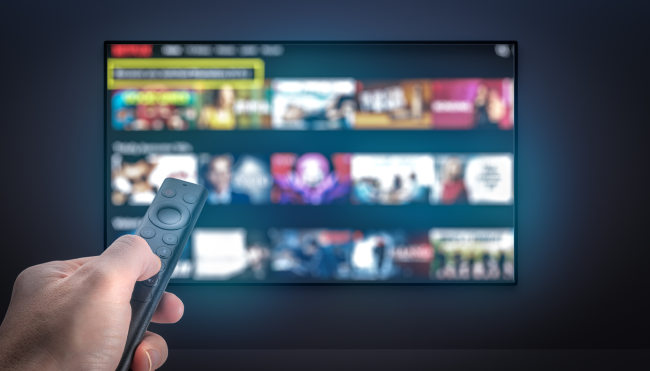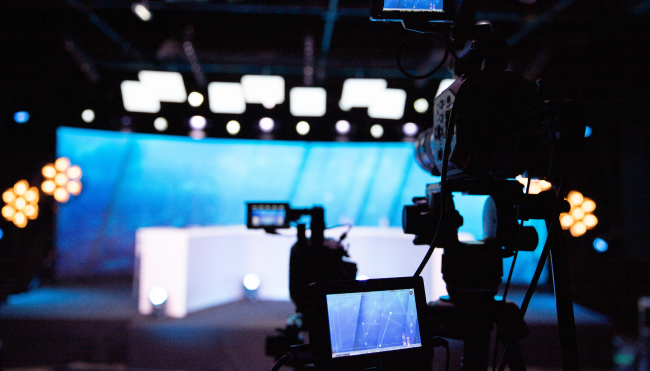- Why Amagi
-
Solutions
Contact UsBusinessWho We Serve
- Offerings
- AI
-
Resources
Contact UsINDUSTRY REPORTSAmagi FAST Report #15: The Power of Live Programming: A Catalyst for Streaming SuccessAugust 21, 2025Read More
-
Company
Contact UsNewsroomAmagi launches AI-powered Smart Scheduler to improve content programmingApril 3, 2025Read More
Blog
FAST advertising: What's in it for advertisers?
By Jon Nevitt - October 11, 2023
Over the past 20 years, streaming television has significantly transformed our content consumption habits. Viewers have more say in choosing content, how to view it, and what they're willing to pay. The growing popularity of Connected TV (CTV) has paved the way for the next big trend - Free Ad-supported Streaming TV (FAST), which has burst onto the scene in millions of households worldwide. The annual FAST ad revenues in the US are expected to hit $6 billion by 2025 – setting advertisers up for success.
We’re here to explain the basics of FAST and how advertisers can maximize ad opportunities across the FAST landscape to enhance their reach and ROI.
What is FAST advertising?

The FAST model, known as Free Ad-supported Streaming TV, delivers pre-programmed content to a large audience through connected TVs. As the name suggests, FAST offers content for free – viewers just have to watch a few short advertisements. Unlike traditional TV, which delivers content through broadcast or satellite signals, FAST is streamed over the internet.
For advertisers, the FAST and Advertising Video On-demand (AVOD) models are promising avenues for better reach and lucrative ROI. AVOD is the on-demand content distribution model where viewers actively choose what they want to watch. It offers content for free or at a lower cost and generates revenue through advertising. YouTube is a great example of an AVOD service. FAST, meanwhile, provides a more passive viewing experience with pre-set linear programming of content and advertising. With FAST, viewers only need a connected TV and an internet connection. This means no hassles of streaming subscription fees or cable bills. Pluto TV, Tubi, and The Roku Channel are a few examples of FAST experiences.
FAST surpasses Subscription Video On-demand (SVOD)
The rise of streaming TV, especially SVOD services like Netflix, Amazon Prime Video, and Disney+, revolutionized how people consume content. The newfound freedom to watch the content of their choice on the internet, when convenient, seemed too good to be true.
But with too many players offering a seemingly infinite pool of content, content discoverability (figuring out what exactly to watch) has become a challenge.
Piling subscription fatigue is another reason why cost-sensitive viewers are looking for more economical options. Today, 86% of consumers pay for more than one subscription monthly, with nearly 10% paying for as many as five streaming services. FAST, with its linear, lean-back experience, addresses both challenges. First, it is free; second, since the content is pre-programmed, the user simply watches what plays in the FAST channel.
The good news is that today, there is a swift viewership shift from SVOD to FAST. Nielsen's ‘The Gauge’ reveals that the growth of FAST between July 2022 and July 2023 is a whopping 71%, whereas SVOD and AVOD have grown by 19% and 27%, respectively – clearly showing the broader adoption of FAST. FAST services like Pluto TV and The Roku Channel reached an all-time high penetration rate of 58% percent in 2022, offering binge-worthy movies and TV shows. FAST viewing time has also increased 70% YoY.

FAST is witnessing a similar trend across the globe, venturing into more living rooms, increasing hours of viewing, and boosting monetization avenues for advertisers.
LEARN MORE: Dive into our industry reports
How FAST advertising works
Ever sit through ads that are repetitive and irrelevant? You’re not alone. A US survey says 51% of adults are bothered by irrelevant ads, and 81% of Gen Z and 57% of millennials prefer watching personalized ads.
Hyper-personalization of FAST ads based on content and context metadata is the key. What's also important is delivering them at lower latency and shorter loading times, improving how viewers perceive ad breaks and enhancing the overall experience. This means better engagement, enhanced CPM (Cost Per Mille), and increased ad revenue. Server-side Ad Insertion (SSAI) and programmatic advertising are crucial in achieving this.
1. Server-side Ad Insertion (SSAI)
SSAI helps deliver personalized ads by stitching the ads into the video stream on the server side, mimicking a cable-like viewing experience with high-quality video and graphics. Solutions like Amagi THUNDERSTORM, an SSDAI (Server-side Dynamic Ad Insertion) solution, further enhance the ad delivery experience through numerous options like pod building, contextual advertising, content localization, and PUP (Per-User Playlist).
Let’s break each one down:
- Pod building: Stitching multiple ads into a single ad break to maximize monetization. Ad podding is similar to commercial breaks on traditional TV that play ads back-to-back.
- Contextual advertising: Helps deliver ads that match the viewer's content type and genre, targeting an already-engaged viewer. For example, showing ads for a superfood brand when the viewer is watching a cooking show on clean eating.
- Content localization: Customizing ads based on regional preferences, such as displaying ads for snow boots in cold, snowy locations.
- Per-User Playlist: Creates personalized ad-viewing experiences at scale. PUP enables users to see a customized ad playlist based on their viewing habits and metrics like demographics, age, behaviors, location, and interests.
2. Programmatic advertising
Programmatic advertising is the automatic buying and selling of digital advertising space, eliminating the need to respond manually to each new media partner's order or contract. It relies on machine learning and data-driven insights to deliver the right ad to the right viewer at the precise moment, cost-effectively. Though programmatic ads are becoming prominent in FAST, they have to fit into ad pods within linear programming, which makes them different from other digital media ads.
Programmatic advertising relies on a protocol called real-time bidding (RTB), which was not initially designed to accommodate linear TV-style advertising pods. With the Interactive Advertising Bureau's (IAB) latest protocol, OpenRTB 2.6, advertisers and publishers can better maximize ad opportunities within FAST advertising pods. These enhancements include the ability to bid on specific pod positions and the ability for publishers to fill their ad pods dynamically with ads of varying lengths. Advertisers bid on a cost-per-second model, which allows buyers with ads of different lengths to compete seamlessly for inventory within the same pod.
The current challenges of FAST advertising

1. Fragmentation
With over 20 FAST services and 1,455+ FAST channels in the US alone as of 2022, audiences get to access a vast pool of content. The downside for the advertisers, though, is that the ad inventory and audience can become fragmented across these services/channels.
Access to more unified measurement data is becoming increasingly important for advertisers to understand their reach, evaluate ad performance, and adjust their marketing budgets. A survey by TiVo revealed that people use an average of 10 different streaming apps – a trend fueled by the rise of AVOD and FAST. Add to this the fragmentation of viewers across devices and platforms, and your advertising data gets more ambiguous.
Besides measurement challenges, navigating ad inventory itself can often be challenging. Content distribution deals often involve bartering ad inventory, meaning that content owners and platforms are often both selling inventory within the same programming. This can create challenges surrounding ad frequency, competitive pod separation, and supply path optimization (SPO) - where programmatic buyers work to avoid bidding on the same ads across multiple channels. Luckily, the IAB and others are continuing to evolve industry standards such as Ad-ID and Ads.txt, which seek to address these issues at scale.
2. Ad experiences
One unique challenge concerning FAST ad experiences is the presence of Slates. A Slate is a master ad that comes encoded in the stream and shown to viewers in case paid ads are not available to be shown for all or part of an ad break duration. Data from Amagi ANALYTICS indicates that the appearance of Slates could cause a user drop-off of up to 10%. While some of these challenges may be addressed by improvements in programmatic buying, such as those introduced by RTB 2.6, Amagi and other leading streaming technology providers are also working on solutions for better customization of the length and placement of streaming ad breaks for each user.
Inconsistency in the length of ad breaks can also hamper user experience and engagement. Numerous research initiatives, including a recent study from TVision, have demonstrated a decrease in engagement with longer ad breaks. As consumers surf between channels, it can also create additional challenges in aligning ad loads for each user. Through our THUNDERSTORM SSAI solution, Amagi has developed a number of innovations to help content owners better optimize ad breaks, and greater personalization will continue to improve these experiences as the FAST ecosystem evolves.
3. Transparency
While FAST excels for advertisers at delivering real-time access to a breadth of programming at scale, data transparency surrounding channel, show, and placement is often inconsistent. Although efforts to manually improve the availability of content metadata have yielded some results, the emergence of AI-driven content classification promises to deliver greater availability of contextual data for targeting and reporting at scale.
How do advertisers benefit from FAST?
1. Shifting consumer attention
Be it a desire for passive watching or not having to pay subscription fees, FAST is evolving to become the future of the lean-back linear experience. With FAST becoming the go-to option, especially amongst millennials and Gen Zs, it makes more sense for advertisers to include FAST in their marketing strategy. A Statista study revealed that Gen Z adults and millennials are more likely to explore FAST services before browsing SVOD platforms than Gen X and baby boomers who explore SVOD first. Millennials are also the largest age cohort of parents with considerable spending power. Their presence on FAST channels opens up a giant opportunity for children's brands to reach their target audience.
2. Advantages over linear TV advertising
The primary strength of traditional linear television is the ability to reach broad audiences at scale by leveraging powerful brand storytelling. As FAST continues to gain scale, it increasingly confers these benefits in addition to offering the ability to deliver more granular targeting and measurement as well as real-time optimization of price, placement, and creative. Traditional TV advertisers can benefit from the ability to tie FAST spending more directly to behaviors like in-store purchases. The ability to run and optimize more targeted campaigns in the FAST environment also attracts new categories of advertisers, such as direct-to-consumer brands. The opportunity to include QR codes and interactive elements more easily unlocks new opportunities to drive sales and capture data across categories.
.gif?width=656&height=369&name=UberEats_Lband%20(1).gif)
3. Innovative ad opportunities
In-content ads are ad formats that run within content, such as overlay ads, rather than within the ad pod. These ads provide new opportunities to engage viewers without disrupting the viewing experience. When customized, targeted, and optimized in tandem with traditional in-stream ads, they can significantly boost the overall efficiency of your campaign. A Media Science and TripleLift Study showed a 32 percentage point lift in brand awareness for advertisers adding in-content ad formats to their campaigns.
.gif?width=656&height=369&name=Apple_Ultra%20(1).gif)
4. Live events are venturing into FAST
Live sports and news consume a significant portion of FAST viewership and engagement today. As content owners continue to respond to meet the demand for live content, advertisers will benefit from the ability to reach engaged audiences at scale. While these are the same benefits that have long driven demand for live events on linear television, FAST also brings the ability for enhanced targeting, measurement, and ad innovation.
Discover more on how Amagi envisions FAST 2.0 here
The future of FAST
Just as personalization is at the core of today's ad landscape, the future of FAST predominantly relies on it as well. Today, every FAST viewer is offered the same set of channels. Personalized EPG will be a groundbreaking evolution in FAST, where each viewer will be presented with a personalized channel, line-up of channels, and personalized program block within a channel. Unlimited content can be made more consumable and customized, meaning enhanced targeting opportunities for advertisers. Interactivity will be another pillar that will drive the change with options like seamless switching between VOD and linear content, options to like, dislike, add to favorites, and shuffle.
With the FAST ecosystem undergoing unprecedented and rapid change, both consumers and advertisers are poised to benefit from improvements in customization, choice, and overall category growth.
Amagi ADS PLUS, our premium CTV marketplace, was built to address many of these challenges and opportunities by unifying FAST audience reach across premium content and leveraging unique contextual data to enhance targeting and transparency. Get in touch with the ADS PLUS team to learn more.
Related Blogs
Get started
Increase revenue and reach with our Broadcast & Streaming solutions.
Cloud modernization. Streaming unification. Monetization. Marketplace.
 German
German French
French Spanish
Spanish Korean
Korean Japanese
Japanese Portuguese
Portuguese


